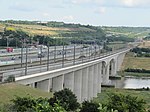HM Prison Rochester
1874 establishments in EnglandPrisons in KentUse British English from May 2018Young Offender Institutions in England

HM Prison Rochester (formerly known as Borstal Prison) is a male Young Offenders Institution, founded in 1874, and located in the Borstal area of Rochester in Kent, England. The prison is operated by His Majesty's Prison Service, and is located next to HMP Cookham Wood.
Excerpt from the Wikipedia article HM Prison Rochester (License: CC BY-SA 3.0, Authors, Images).HM Prison Rochester
St Johns Way,
Geographical coordinates (GPS) Address Nearby Places Show on map
Geographical coordinates (GPS)
| Latitude | Longitude |
|---|---|
| N 51.37 ° | E 0.48861111111111 ° |
Address
Fort Borstal
St Johns Way
ME1 3NG , Troy Town
England, United Kingdom
Open on Google Maps









